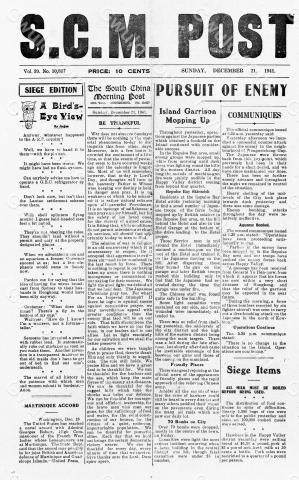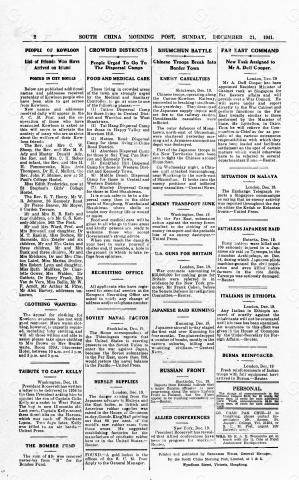Today the Japanese defeat the last attempt to relieve Wong Nai Chung Gap and the island is now irrevocably cut in half. Japanese troops land in Causeway Bay headed for Victoria {now Central}. Governor Sir Mark Young sends a telegram to the Admiralty saying that the enemy holds key positions and soon the defenders will be reduced to holding 'a small pocket in centre of city leaving bulk of fixed population to be overrun'. He seeks permission to 'ask terms' before that happens. He's told that his telegram crossed a message from Churchill - 'we expect you to resist to the end'.
The general conditions are becoming critical too:
In Victoria, electricity and gas are cut off. The civilians now have no light, heat or water.
The absence of electricity - and probably the advance of the Japanese westwards towards Victoria - forces Thomas Edgar and his fellow bakers to abandon the Lane, Crawford Bakery in Stubbs Rd. Edgar has previously placed hops and other supplies in various Chinese bakeries, and he now opens the Yoke Shan and Qing Loong bakeries in Queen's Road East. These are too small to produce the bread needed, and more bakeries must be opened, so army help is sent for.
Joan Crawford and the other survivors of the Power Station siege finally get to eat in the evening - 'a handful of rice cooked on the beach'. This ends four days without food, and the men are allowed to go back to the Station to get clothes and bedding.
They watch the soldiers being brought to the clearing point 'in pitiful condition', but they are not allowed to approach them.
They're kept at the North Point Camp until the end of hostilities and then sent to The French Hospital - 'where the sisters were so good to us'. From there they go into Stanley on January 29.
In Government House they've burnt all the codes and ciphers. Sir Mark Young's secretary, Joyce Bassett, is asked by a friend to rescue his wife and mother-in-law from an area being mortared by the Japanese. Mr. Butters, forbids her to go, but Police Commissioner Pennefather-Evans lends her a car, and she manages to get the two women, and 'another American lady' down just in time - a Canadian soldier tells her the position will be abandoned to the advancing Japanese in an hour.
The Repulse Bay Hotel comes under heavy mortar fire all morning. Major C. Templer is given overall command in the area. He arrives at the Hotel, does his best to organise the defenders and talks to Major C. M. Manners (retired) about the situation of the civilians.
Sources:
Military situation, messages, conditions in Victoria: Tony Banham, Not The Slightest Chance, 2003, 187-193
Edgar: Thomas Edgar, Article in The British Baker, September 13, 1946
Crawford: Austin Coates, A Mountain Of Light, 1977, 49
Bassett: Alan Birch and Martin Cole, Captive Christmas, 1979, 129-130
Repulse Bay Hotel: John Luff, The Hidden Years, 109-110
Note:
For further developments in baking see Staff-Sergeant Sheridan's hostilities and escape diaries. Sheridan and Sergeant Hammond arrived on December 23 after an eventful journey: http://gwulo.com/node/13844

